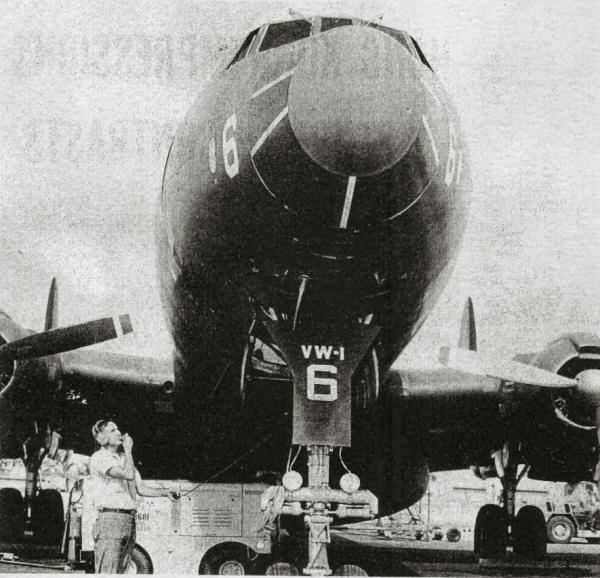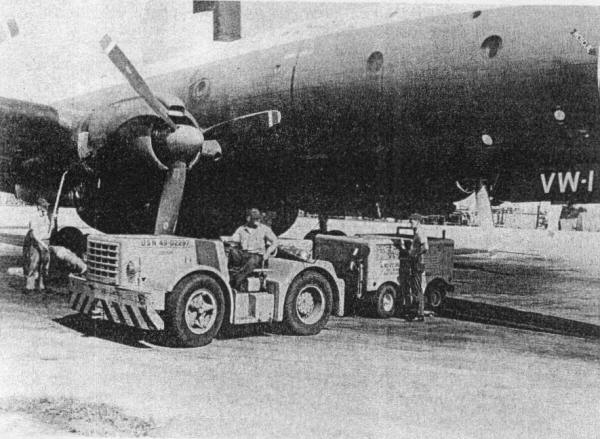
Head Director T.D. Scott, ABAN, exchanges last minute information with the aircraft's pilot. He and the other men of AERON-1's Line Crew are vital contributors and a major ingredient in the squadron's receipt of Safety Awards from ComNavArPac for the past 30 quarters.
(Photos by J.L. Ashbey, PH3, VAP-61)
VW-1 CREW IS
VITAL TO MISSION
By Aeron-1 PIO
In every military squadron or commercial airline, there is a small group called the Line Crew. They are a little known division of men that neither fly, wear wings nor win medals. However, without them no aircraft can taxi between a runway and its parking area. They do for an aircraft what a tug does a ship, take it in and out of its berth.
At Airborne Early Warning Squadron One, the Line Crew consists of 22 men. Twenty of them are non-rated Airmen and two are Petty Officers. Nearly all of them are under twenty years of age. Nearly all are paid less than $100 a month while their commercial counterpart makes as much as $100 a week.
Aeron-1 Line Crew is responsible for about thirty pieces of Ground Support Equipment (GSE), valued at $250,000. The equipment generates enough power to run the Agana Naval Air Station where the squadron is located. It is also used by the crew to maintain and direct the eight squadron aircraft valued at over $50,000,000. Men no longer just "drive" GSE, but with the squadron's new complex equipment, they must be licensed operators.
A typical Line Crew billet is Taxi Director. Training takes six to seven months and 90 per cent of the division have completed a lengthy, training school. To direct a giant EC-121K from its parking ramp to the runway takes six men. The Directors make all recommendations to pilot whose visibility is limited as he sits in the cockpit of an aircraft that requires 20,000 square feet of parking space each. Naturally, that 20,000 square feet of necessary space rolls with the aircraft.

Part of the ground crew required to start an EC-121K. (L-R) J.A. Pluhar, AMAN, holds a fire bottle on one of the four 3400 horsepower engines; P.W. Zimmerman, ADAN, backs the tow tractor; R.J. Sawdey, ADAN, plugs in a power cable; and C.D. Hubert, ADAN, monitors the power panel.
When the Line Crew personnel have the "duty", they must physically remain in the squadron area for 24 hours. During this time, they are responsible not only for the movement of all aircraft but safety during the fueling operations and checks for fuel contamination. Many Senior Petty Officers who have become Crew Chiefs in the squadron started out from a Line Crew. With that invaluable experience, they are well trained to take care of the aircraft when it is deployed.
Although these men work continually around volatile gasolines and whirling propellers, they receive no hazardous duty pay. The only complaint ever heard by a Line Crewman is since his responsibilities are great he usually is working with senior rated personnel. This makes winning an argument rare!
No matter what time of day or what part of the world you find the Line Crews working, professional aviators agree that they are one of the most respected and competent groups in aviation. This vital ingredient in Aeron-1 has also been a major contributor to the squadrons receipt of the Commander Naval Air Force, U.S. Pacific Fleet Quarterly Aviation Safety Awards for the past 30 quarters.

